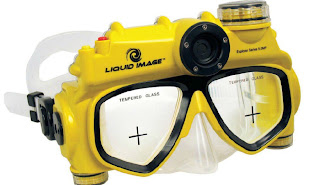Reviews : Apple iPod touch, A Sleeker, Speedier touch
 It’s cheerful, colorful and versatile, and though it technically has competition, Apple’s iPod touch still stands alone. More like a smartphone without the phone than an MP3 player, it brings more than 700,000 iOS apps along with iTunes, iBooks, and the rest of the Apple ecosystem to folks who don’t want to pay full iPhone freight. This year’s touch is faster, with a much better screen, a new camera, better earphones, and a new body design to die for—but this five-star product comes at a three-star price. There’s nothing like it that’s quite as good, but the entry-level $299 price (for 32GR of storage space) is much more costly for all the people who want to use it for light gaming, Web browsing, and music.
It’s cheerful, colorful and versatile, and though it technically has competition, Apple’s iPod touch still stands alone. More like a smartphone without the phone than an MP3 player, it brings more than 700,000 iOS apps along with iTunes, iBooks, and the rest of the Apple ecosystem to folks who don’t want to pay full iPhone freight. This year’s touch is faster, with a much better screen, a new camera, better earphones, and a new body design to die for—but this five-star product comes at a three-star price. There’s nothing like it that’s quite as good, but the entry-level $299 price (for 32GR of storage space) is much more costly for all the people who want to use it for light gaming, Web browsing, and music.
PHYSICAL DESIGN AND WI-FI
The new iPod touch is one of the most elegant devices I’ve ever handled. Measuring an amazing 0.24 inch thick and weighing only 3.1 ounces, it’s almost two-dimensional and weightless. Its increased 4.86-inch length lets it accommodate a super-sharp 4-inch, i,i36-by-640 screen, but its width is the same as that of previous touches (2.31 inches). The new display is just like the iPhone 5’s, and noticeably brighter than the previous touch’s screen. Even the aluminum casing, available in blue, pink, red, yellow, gray, or black, looks better. On the bottom you’ll find an extremely tinny-sounding speaker, the 3.5mm headphone jack, and Apple’s new Lightning connector, which isn’t natively compatible with existing accessories without a $29 adapter.
In the box you get a pair of Apple’s vastly improved EarPods, and a color-coordinated wrist strap that attaches to a pop-out button on the card slot for expansion here: Built-in storage is all you get.)
Battery life was a bit disappointing: The touch lasted 4 hours, 55 minutes of video playback with the screen at full brightness and Wi-Fi on.
CAMERA AND MULTIMEDIA
The 5-megapixel rear camera is one of the touch’s flagship features, but I’m lukewarm on the entire concept. Yes, it’s much better than the previous iPod touch camera, but it’s still just a decent smartphone camera. The 5-megapixel main camera and 1.2-megapixel front camera take sharp shots outdoors with plenty of light, but sharpness and focus suffer in low light. I also saw some serious problems with the autofocus locking in when the flash was needed.
In terms of video recording, we captured io8op video with the main camera and 720P with the front camera, each at 30 frames per second (fps) outdoors. But in moderate indoor lighting, that dropped to 27fps on the main camera and 24fps on the front camera with focus problems.
Remember that you can get a good, basic 14.1-megapixel camera with optical zoom for about $100 nowadays; if the touch cost $199 rather than $299,1 wouldn’t be complaining. The rear camera here is a “nice-to-have” feature, but I don’t see it as a core part of the iPod touch experience. The front camera, on the other hand, works with FaceTime, turning the iPod touch into a terrific video phone when you’re connected to a Wi-Fi hotspot.
Music and video playback are as high quality as always; sound is still quite bright, if a little weak on bass. The touch still syncs with iTunes (although now it can do so wirelessly) and still plays any MP3 or AAC music or MPEG-4 video file, whether purchased from Apple or downloaded from elsewhere. The touch also plays Audible, Apple Lossless, AIFF, and WAV, but not FLAC or OGG, files; and the array of streaming video apps on iOS is unmatched.
CONCLUSION
There are a few Android-based music players out there, but none of them can touch the touch. The device’s true competition might be $200 7-inch tablets like the Amazon Kindle Fire HD and the Google Nexus 7, which offer top-notch Web browsing, e-reading, and gaming experiences on a larger screen for $100 less than the touch— although neither will slip into a pocket.
As a music player, the $299 touch is overkill. Teens who want to play Talking Tomcat, Fruit Ninja, and Temple Run can stick with the $199 entry-level iPod touch—and if you already have that, there’s no reason to jump on this one. If you need a good camera, buy an entry-level point-and-shoot and save some cash. But if you were intending to use your touch to store and play a lot of music or videos, spring for the new model. Once you’re looking at 32GB of storage the difference between the two devices drops to $50, and the bigger screen, lighter body, and even the camera make a real difference in the experience.
 Steve Jobs may no longer be around to manage Apple, but we’re only now starting to enter the post-Jobs era.
Steve Jobs may no longer be around to manage Apple, but we’re only now starting to enter the post-Jobs era.
Because product cycles are long, the new Apple gadgets we’re seeing now are all devices Jobs had a real hand in creating. It’ll be at least another six months before we see the first Apple gadgets without Jobs’ ideas.
Apple has been able to move ahead in the past year through a combination of Jobs’ ideas and the team he set up. Scott Forstall’s departure in late October was a telling sign of generational change.
"Steve Jobs Is Not Dead"
Forstall had worked with Jobs since the 1990s, and had a strongly Jobsian personality; Jobs’ pick to head Apple’s retail stores, Ron Johnson, left the company in 2011.
But let’s not overplay the changes here. This isn’t like when Jobs was first ousted from Apple in 1985 and replaced with bozos like Michael Spindler and Gil Amelio, who ran the firm into the ground. Jony Ive, Phil Schiller, and most importantly Tim Cook all worked with and learned from Jobs for years.
The company’s missteps, like the messed-up Maps app, might well have happened under Jobs.
Remember that not everything he did turned to gold. He was just good at making people think so—and that, perhaps, is the Steve Jobs magic that the company is missing right now. The Jobs era brought us the G4 Cube, the Motorola ROKR, troubled iPhone 4 antennas, the doomed Ping social network, and an apology for a screwed-up Mobile Me launch. The new Maps app had been in the works at least since 2009, when Jobs was hale and hearty. It’s another one of his projects.
Mobile devices, especially, take years to build. When I talk to carriers and manufacturers, they describe a product cycle of 18 to 24 months from conception to sale. The iPhone 5 may have been in the works even longer. When the iPhone 4S came out, many Apple watchers were surprised because they’d been hearing rumors of a very different iPhone, one with an all-metal body. That concept, from 2011, may have eventually evolved into the iPhone 5.
So Maps and the iPhone 5 are Steve Jobs legacies. How about the iPad mini? Jobs famously disparaged 7-inch tablets, saying that they were only usable by deformed mutants. But it was a common rhetorical strategy of Jobs to curse whatever he was working on at the moment. Jobs said that nobody wanted to read books on an LCD screen, and then released iBooks; he said that nobody wanted to watch video on a handheld, and then released the video iPod. The iPad mini has already sold millions.
Let’s also look at the fourth-generation iPad, which existing users have been criticizing for coming “too soon” after the previous model. Jobs had no problem with mid-cycle course corrections. Remember how he lowered the original iPhone’s price by $200 six months after its release? He might have been better at defusing user anger than the current administration is, but I’m confident that will blow over.
Apple’s corporate structure seems to have changed a bit since Jobs’ death. Tim Cook isn’t taking up all the limelight the way Jobs did, but Apple is still the uniquely secretive place Jobs set up. Yes, there have been leaks, but there have always been leaks—Gizmodo’s iPhone 4 scoop came during the Jobs era. Apple’s PR operation still functions like no other, and we haven’t heard about major structural changes. The system isn’t broken—thanks in part to Jobs, Apple’s stock seems to keep going up and up—so the Cupertino folks aren’t fixing it.
But that might be where Jobs’ death finally starts to matter.
THE IMPENDING DEATH OF STEVE JOBS
It’s impossible to know much about Apple’s future until the 2013 holiday season. The Jobsian product pipeline will dry up then, and it will be much more urgent for Apple to react nimbly to competitors. Apple’s iOS success has become self-perpetuating because of its terrific third-party developer community, but that doesn’t have an infinite life span.
Apple hasn’t entered a new market since it introduced the iPad in 2010. It hasn’t taken a big bet. Will post-Jobs Apple have the will and bravery to blow things up and disrupt markets the way it did under Jobs with the iPhone and iPad? Apple is no longer an underdog; it’s the leader in tablets, and the world’s most profitable cell phone maker. As Microsoft can tell you, leadership creates a tendency towards inertia.
Tim Cook is a spectacular operational leader, but he hasn’t yet shown himself to be an idol smasher. Without Jobs’ (and Forstall’s) notoriously prickly genius on board, the question isn’t whether Apple can continue to sell lots of its existing product categories, but whether it will be able to anticipate the next one.

The Tech of Skyfall
 Technology is as much a part of any James Bond film as an Aston Martin, scantily clad women, and 007 himself—shaken, not stirred, of course. But the newest Daniel Craig-powered title, Skyfall, takes tech to a new level, while still keeping things classy.
Technology is as much a part of any James Bond film as an Aston Martin, scantily clad women, and 007 himself—shaken, not stirred, of course. But the newest Daniel Craig-powered title, Skyfall, takes tech to a new level, while still keeping things classy.
Gadgets abound when Q, the new, young Quartermaster, sends Bond along his merry way with new field equipment, including a biometrically encoded Walther PPK, which is coded to Bond’s palm prints and lets him, and only him, fire the gun. There’s also a radio transmitter to trace Bond’s whereabouts.
Q boasts during his first meeting with Bond that he can “do more damage on my laptop in my pajamas” than the secret agent can do in a year in the field. That same principle is demonstrated by the filmmakers, who worked with top-level cameras, computers, and stunt equipment to produce Skyfall, the 23rd James Bond movie.
The movie’s stunt coordinator, Gary Powell, chatted with PC Magazine about the technology used in front of and behind the cameras, how advancing technology has shaped the Bond universe, and what it’s really like to work with classic icons of 007 history.Could you talk a little bit about the technology that was used in the cars in the movie, and the role that plays in the film?
 One of the biggest pieces of technology we use is this thing called the pod, which basically sits on top of the car, and allows the stunt guys to drive the car while the actors are inside it, acting. And it allows us to make the cars go a lot faster, put them more right on the line doing action. You have to [make sure] the actors inside are totally safe; they’re concentrating on their acting. All the mechanics inside the car [are] connected, so if they pull the steering wheel the wrong way, it’s not going to affect the car or anything like that. For us, that is a huge help, because we can put the camera in better places, [and] we can put the actors in better action scenes.
One of the biggest pieces of technology we use is this thing called the pod, which basically sits on top of the car, and allows the stunt guys to drive the car while the actors are inside it, acting. And it allows us to make the cars go a lot faster, put them more right on the line doing action. You have to [make sure] the actors inside are totally safe; they’re concentrating on their acting. All the mechanics inside the car [are] connected, so if they pull the steering wheel the wrong way, it’s not going to affect the car or anything like that. For us, that is a huge help, because we can put the camera in better places, [and] we can put the actors in better action scenes.
How important was it to have the car technology, particularly the Aston Martin, in the film?
 It’s a flashy piece of Bond history. The diehard fans love it when that car turns up, and the new ones—it’s an introduction for them. We’ve got new technology now where we can still put that car there with the machine guns and all that sort of stuff, and it really just adds to the film. It’s actually one of our favorite parts of the film when that car turns up. It sort of becomes a James Bond film totally.
It’s a flashy piece of Bond history. The diehard fans love it when that car turns up, and the new ones—it’s an introduction for them. We’ve got new technology now where we can still put that car there with the machine guns and all that sort of stuff, and it really just adds to the film. It’s actually one of our favorite parts of the film when that car turns up. It sort of becomes a James Bond film totally.
![]()
TAGG—THE PET TRACKER
It’s 10 p.m. Do you know where your pets are? The Tagg tracker uses advanced GPS location technology to keep tabs on your four-legged friends. If they stray from designated areas, the system will send you an email or text alert. It can also monitor your pup’s activity with charts and timelines to make sure it is getting the recommended 30 to 60 minutes of daily exercise. The tracker fits on existing collars and is, of course, waterproof.
Review : Under Water Camera : LIQUID IMAGE EXPLORER SERIES
Posted by john mathhew | 7:11 AM | reviews
Review : Under Water Camera : LIQUID IMAGE EXPLORER SERIES

Whoever invented the underwater camera clearly neglected to address one vital detail: You need your hands to swim. Now, as Finding Nemo's Dory would say, you can “just keep swimming,” because Liquid Image has made a swim mask with a built-in waterproof digital camera. Available in 8- and 3.1-megapixel models, the camera can take still shots and shoot video at a depth of up to 15 feet. It has 16MB of integrated storage and a microSD card slot for adding more.